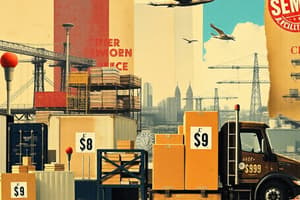Podcast
Questions and Answers
Which of the following is a key component of customer service as perceived by customers?
Which of the following is a key component of customer service as perceived by customers?
What is the first step in establishing the relative importance of customer service components?
What is the first step in establishing the relative importance of customer service components?
Which of the following best describes a common mistake in customer service segmentation?
Which of the following best describes a common mistake in customer service segmentation?
How can customers rank service components to reflect their preferences effectively?
How can customers rank service components to reflect their preferences effectively?
Signup and view all the answers
What should be considered a pre-transaction element in customer service?
What should be considered a pre-transaction element in customer service?
Signup and view all the answers
Which element is included in the pre-transaction phase of customer service?
Which element is included in the pre-transaction phase of customer service?
Signup and view all the answers
What is a key focus area for improving customer retention strategies?
What is a key focus area for improving customer retention strategies?
Signup and view all the answers
Which of the following represents a transaction element in customer service?
Which of the following represents a transaction element in customer service?
Signup and view all the answers
What should NOT be the primary focus when designing a logistics system?
What should NOT be the primary focus when designing a logistics system?
Signup and view all the answers
Which statement accurately reflects the relationship between retained customers and profitability?
Which statement accurately reflects the relationship between retained customers and profitability?
Signup and view all the answers
Which of the following is a commonly recognized post-transaction element?
Which of the following is a commonly recognized post-transaction element?
Signup and view all the answers
In understanding customer service needs, what is essential to consider?
In understanding customer service needs, what is essential to consider?
Signup and view all the answers
What should companies prioritize to maintain a competitive advantage over others?
What should companies prioritize to maintain a competitive advantage over others?
Signup and view all the answers
What is the primary goal of defining customer service objectives in a market-driven logistic strategy?
What is the primary goal of defining customer service objectives in a market-driven logistic strategy?
Signup and view all the answers
Which of the following best describes the 'perfect order' in customer service?
Which of the following best describes the 'perfect order' in customer service?
Signup and view all the answers
What does the '80/20 rule' imply regarding customer profitability?
What does the '80/20 rule' imply regarding customer profitability?
Signup and view all the answers
In the context of managing product service levels, what should be prioritized in Quadrant 1 of the 80/20 rule?
In the context of managing product service levels, what should be prioritized in Quadrant 1 of the 80/20 rule?
Signup and view all the answers
What element of customer service measures the proportion of total orders delivered on time?
What element of customer service measures the proportion of total orders delivered on time?
Signup and view all the answers
Which of the following is an important aspect of post-transaction elements in customer service?
Which of the following is an important aspect of post-transaction elements in customer service?
Signup and view all the answers
What do order cycle times measure in customer service dimensions?
What do order cycle times measure in customer service dimensions?
Signup and view all the answers
Which strategy would be employed in Quadrant 3 of managing product service levels?
Which strategy would be employed in Quadrant 3 of managing product service levels?
Signup and view all the answers
Study Notes
Customer Service Dimensions
- Customer service is providing 'time and place utility' or 'availability'.
- Determining customer service involves all factors that affect product and service availability to buyers.
- Lalonde and Zinszer's study divided customer service into pre-transaction, transaction, and post-transaction elements.
Mission of Logistics Management
- Logistics management ensures customer service requirements are met.
- Every entity in the supply chain impacts customer service, regardless of its proximity to the marketplace.
- A visualized diagram depicts the relationships between suppliers, procurement, operations, distribution, and customers, showing the flow of materials and information.
The Marketing and Logistics Interface
- The Four Ps (Product, Price, Promotion, and Place) are crucial marketing elements.
- 'Place' refers to delivering the right product at the right time and place.
- Traditionally, 'place' wasn't considered a core marketing element.
- Currently, customer service is becoming a primary differentiator in the market.
Why Customer Service is a Differentiator
- Constant customer expectation evolves.
- Products are becoming commodities.
- Technology accessibility diminishes product differentiation.
- Brand value decreases.
Smartphone Features and Customer Considerations
- Processor speed (e.g., 3.0 GHz), RAM (e.g., 8 GB), camera resolution (e.g., 108 MP), and battery life (e.g., 24 hours) are common smartphone features.
- Non-experts may struggle to interpret feature impact on their daily use.
- Customers evaluate brand reputation through reviews and user experiences.
- Pricing comparison is a key aspect of customer decision-making.
Typical Customer Services
- Pre-transaction services cover stock availability, target delivery dates, and response times to queries.
- Transaction services include order fulfillment rates, on-time deliveries, and backorders.
- Post-transaction services encompass first-call fix rates, customer complaints, invoice errors, and service part availability.
Customer Service vs. Cost Reduction
- Focusing solely on product development, promotions, and pricing isn't enough to gain a competitive advantage.
- Cost reduction is important as long as the process doesn't jeopardize value creation.
- Low-cost strategies can lead to efficient, but not effective, logistics.
Customer Service and Retention
- Customers are driven by benefits, not just products.
- The focus shifts to service as core products become commodities.
- Companies relying on product features alone may face difficulties in retaining customers.
- Satisfied customers are less likely to consider alternatives and thus increase profitability for businesses.
- Retained customers are often more valuable than new ones.
Creating Service-Driven Logistics
- A service-driven logistics system targets meeting defined service goals.
- Re-engineering logistics systems solely for internal cost reduction is not an effective strategy.
Identifying Customer Service Needs
- Customer service needs vary considerably.
- Customers can be grouped based on similar service requirements.
- Company performance measures might not accurately reflect customer values.
- Thorough market research to understand customer needs and segmentation is critical.
Approaches to Customer Segmentation
- Determining key service components from customer perspectives is essential.
- Establishing relative importance of service components as perceived by customers is crucial.
- Identifying customer clusters according to similar service preferences helps in optimizing strategy.
Identifying Key Components of Customer Service
- Gaining insight into customer needs through research.
- Determining the ideal purchaser for products.
- Employing surveys to elicit feedback on customer needs.
- Understanding customer service importance relative to other crucial elements (e.g., product, price, promotion).
Establishing Relative Importance of Customer Service Components
- Surveying representative samples to ascertain service component rankings.
- Standardizing a rating scale (e.g., 1-10) ensures consistent ranking of service elements.
Identifying Customer Service Segments
- Using computer-based cluster analysis to identify groups with similar service preference priorities.
Defining Customer Service Objectives
- Creating a market-driven logistics strategy aims at consistent service excellence.
- The "perfect order" implies satisfying all customer needs, encompassing factors like speed, completeness, damage-free, etc.
- Targeting decisions on how much and to whom service is provided is core to successful implementation.
The Pareto or 80/20 Rule
- Eighty percent of profits often come from only 20 percent of customers.
Managing Product Service Levels Using the 80/20 Rule
- Quadrant 1: Seek cost reduction for products with low profit contribution and sufficient volumes.
- Quadrant 2: Maximize availability for products significant to customers.
- Quadrant 3: Review products with limited importance and volumes.
- Quadrant 4: Focus on Just-In-Time (JIT) for products with high demand and contribution.
Typical Customer Service Standards
- Order cycle time: Time from customer order to delivery.
- Stock availability: Percentage of demand met from available inventory.
- Order-size constraints: Capacity to meet customer demand ranges.
- Ordering convenience: Ease of doing business with the company.
- Delivery reliability: Proportion of orders delivered on time.
- Documentation quality: Error rate in documents.
- Claims procedure: Ease and speed of customer complaint resolution.
- Order completeness: Proportion of complete orders delivered.
- Technical support: Standards for call-out times and first-time fix rates.
- Order status information: Accessibility of order status data.
Studying That Suits You
Use AI to generate personalized quizzes and flashcards to suit your learning preferences.
Related Documents
Description
Explore the critical dimensions of customer service and its relationship with logistics management. This quiz covers the different elements of customer service and how they interact with logistics to ensure availability and satisfaction. Test your understanding of the marketing and logistics interface, including the Four Ps.




